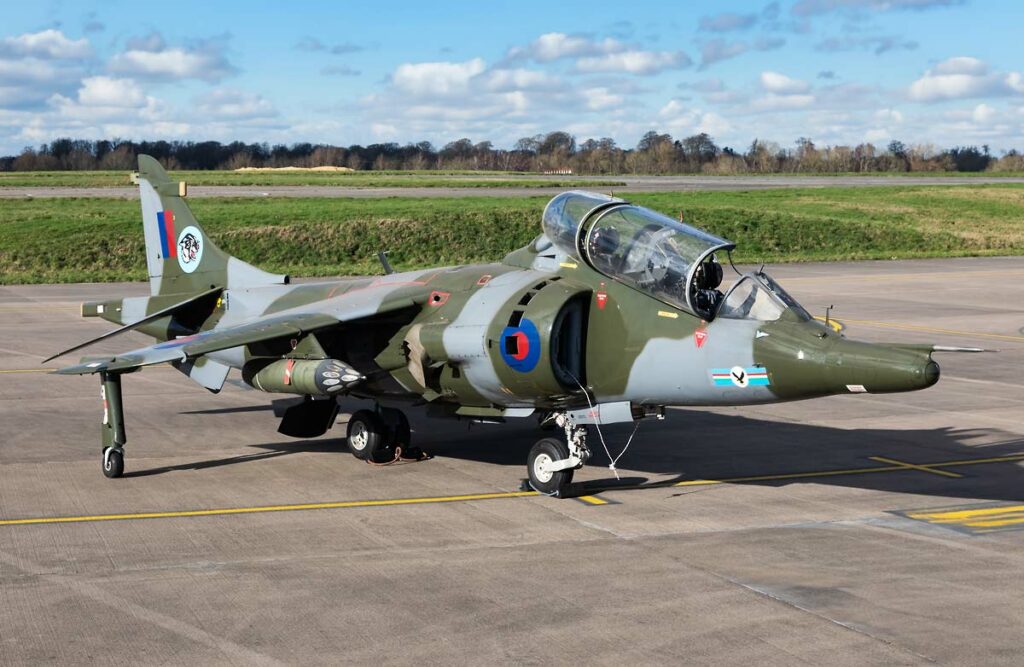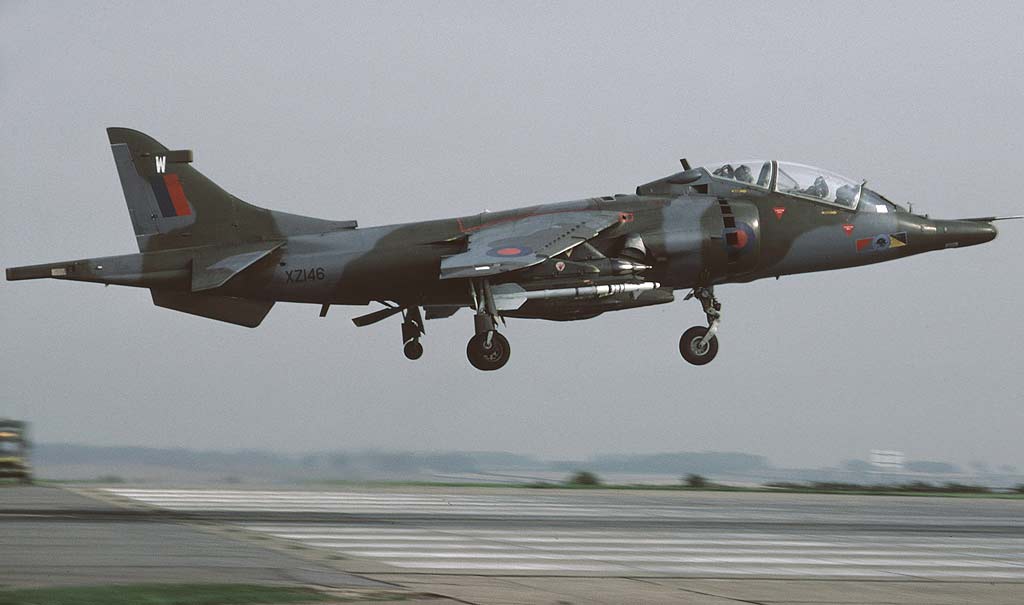The Harrier, known for its V/STOL capabilities, revolutionized modern warfare with its ability to operate from short runways and improvised bases.
In brief
The Hawker Siddeley Harrier, later known as the AV-8A in U.S. service, was the world’s first operational jet-powered Vertical/Short Takeoff and Landing (V/STOL) aircraft. It was powered by the innovative Pegasus engine, which featured four swiveling nozzles, allowing the jet to take off vertically, hover, and fly in a conventional manner. With a top speed of over 730 mph and a range of approximately 300 miles, it was armed with a combination of cannons, rockets, missiles, and bombs. The Harrier’s unique design allowed for flexibility in deployment, significantly enhancing its tactical utility in various combat scenarios.

History of the Development of the Hawker Siddeley Harrier/AV-8A
The Hawker Siddeley Harrier emerged from the 1960s British need for a combat aircraft that could operate from improvised bases and small carriers, negating the need for long, vulnerable runways which could be easily targeted during the Cold War. The project, initiated by Hawker Aircraft Ltd, led to the innovative P.1127 prototype, which first flew in 1960, evolving into the Kestrel FGA.1 for evaluation purposes.
Officially entering service as the Harrier GR.1 in 1969 with the RAF, its design was a response to the demands of modern warfare, where flexibility and rapid deployment were crucial. The U.S. showed interest in this novel aircraft, leading to the AV-8A Harrier version for the United States Marine Corps, which first flew in 1971. The Harrier was not assigned a specific NATO reporting name due to its distinctiveness and Western origin.
Design of the Hawker Siddeley Harrier/AV-8A
The Harrier was engineered with a groundbreaking thrust vectoring system in its Rolls-Royce Pegasus turbofan engine, allowing the aircraft’s nozzles to be pointed downward for vertical takeoff and then shifted rearward for horizontal flight. Its design was optimized for air-to-ground operations but retained air-to-air combat capabilities. The aircraft featured a high-mounted wing, allowing for the clearance of the jet nozzles beneath, and incorporated large reaction control valves at the wingtips, nose, and tail for maneuvering at low speeds and hovering.
Despite its versatility, the Harrier had limitations, including a relatively high pilot workload due to the demands of managing the V/STOL capabilities, and initial susceptibility to bird strikes. However, its ability to operate from carriers, forward bases, and even cleared woodland areas provided unparalleled operational flexibility.
Performance of the Hawker Siddeley Harrier/AV-8A
The Harrier’s performance was characterized by its V/STOL capability, courtesy of the Pegasus engine, producing around 21,500 pounds of thrust. This allowed the aircraft to operate from short runways, helicopter pads, or even cleared forest areas, significantly expanding its operational reach. It had a maximum speed of Mach 0.9 and could carry a wide range of ordnance, including air-to-air missiles, air-to-surface missiles, bombs, and a 25mm cannon in a gun pod.
Its operational radius was somewhat limited, necessitating careful mission planning or in-flight refueling for extended operations. Despite these constraints, the Harrier’s unique operational profile provided significant tactical advantages, such as close air support with rapid response times and the ability to evade traditional air defenses by operating at low altitudes.
Variants of the Hawker Siddeley Harrier/AV-8A
The Harrier family includes several variants, each designed for specific roles:
- GR.1/GR.3: The initial RAF versions, with the GR.3 featuring improved sensors and avionics.
- AV-8A: The USMC version, similar to the GR.1 but tailored to American specifications.
- Sea Harrier: A navalized version developed for the Royal Navy, equipped with a radar for fleet air defense.
Each variant showcased the platform’s adaptability to different operational needs, from close air support to naval air defense.

Military Use and Combat of the Hawker Siddeley Harrier/AV-8A
The Harrier saw extensive combat use, most notably by the British during the Falklands War in 1982, where it played a crucial role in achieving air superiority and providing close air support. Its ability to operate from forward bases and carriers was instrumental in the conflict’s remote South Atlantic setting.
The U.S. Marines employed the AV-8A in various conflicts, appreciating its rapid deployment capability and effectiveness in close air support roles. It was particularly valued for its versatility in expeditionary missions, able to be deployed quickly to hot spots around the globe. The Harrier’s operational history includes significant involvement in Operation Desert Storm, where it conducted hundreds of sorties against Iraqi forces, demonstrating its effectiveness in strike missions and its resilience in sustaining operations under challenging conditions.
The aircraft’s V/STOL capabilities allowed for forward basing close to the front lines, reducing response times for close air support and enabling sustained presence over battlefields, a crucial factor in modern warfare where air dominance and timely ground support can be decisive. The Harrier’s ability to hover also made it particularly effective in reconnaissance and the precise delivery of munitions, features that were exploited to great effect in various NATO-led operations in the Balkans during the 1990s.
Despite its combat successes, the Harrier faced challenges, including vulnerability to ground fire due to its operational envelope near the battlefield and the high workload for pilots, particularly in hovering flight which demanded significant skill and concentration. Nevertheless, the aircraft’s contributions in numerous conflicts underscore its strategic value.
–
The Hawker Siddeley Harrier, later known as the AV-8A in its American guise, stands as a monumental achievement in aviation history, being the first operational V/STOL jet aircraft. Its development marked a significant technological leap, overcoming numerous challenges to create an aircraft that could take off and land vertically yet still achieve speeds and maneuverability comparable to conventional fixed-wing jets. This capability allowed the Harrier to operate from almost anywhere, providing unmatched operational flexibility and tactical advantages.
The Harrier’s legacy is defined by its revolutionary contribution to military aviation, demonstrating the strategic value of V/STOL aircraft in modern warfare by offering a combination of agility, flexibility, and power projection previously unattainable. Its operational record, marked by adaptability and resilience, has proven the concept’s viability and set the stage for further advancements in V/STOL technology. As military doctrines evolved to emphasize rapid deployment and versatility, the Harrier’s pioneering design paved the way for future innovations in aerospace engineering, securing its place in the annals of military aviation history.
Back to the Fighter Jet section.